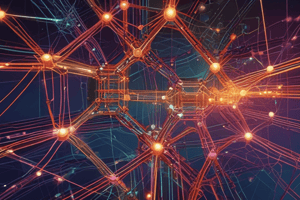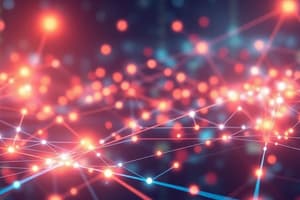Podcast
Questions and Answers
Which component of data communication is responsible for transmitting the message?
Which component of data communication is responsible for transmitting the message?
- Protocol
- Receiver
- Sender (correct)
- Transmission Medium
What defines a set of rules that governs data communication between devices?
What defines a set of rules that governs data communication between devices?
- Protocol (correct)
- Transmission Medium
- Message
- Receiver
Which of the following is NOT a characteristic of data communication?
Which of the following is NOT a characteristic of data communication?
- User Accessibility (correct)
- Accuracy
- Delivery
- Protocol Compliance
Which type of network topology connects all devices in a circular path?
Which type of network topology connects all devices in a circular path?
What type of network would you classify a network that covers a specific campus area?
What type of network would you classify a network that covers a specific campus area?
Which of the following is a key feature distinguishing packet-switched networks from circuit-switched networks?
Which of the following is a key feature distinguishing packet-switched networks from circuit-switched networks?
What is the primary role of the transmission medium in data communication?
What is the primary role of the transmission medium in data communication?
What is the primary difference between packet switching and circuit switching?
What is the primary difference between packet switching and circuit switching?
In datagram packet switching, how are packets treated as they pass through the network?
In datagram packet switching, how are packets treated as they pass through the network?
What is included in each packet to assist with its routing in virtual circuit packet switching?
What is included in each packet to assist with its routing in virtual circuit packet switching?
What does the receiver have to do when packets arrive out of order in a datagram packet switching network?
What does the receiver have to do when packets arrive out of order in a datagram packet switching network?
Which of the following statements correctly distinguishes virtual circuit packet switching from datagram packet switching?
Which of the following statements correctly distinguishes virtual circuit packet switching from datagram packet switching?
Which device is primarily used for internetworking between LAN and WAN?
Which device is primarily used for internetworking between LAN and WAN?
What type of intermediary network device can regenerate signals for network extension?
What type of intermediary network device can regenerate signals for network extension?
In a BUS network topology, how are nodes connected?
In a BUS network topology, how are nodes connected?
Which type of network topology is most commonly used due to its simplicity and ease of extension?
Which type of network topology is most commonly used due to its simplicity and ease of extension?
What is the main function of a firewall in a network?
What is the main function of a firewall in a network?
Which of the following media uses glass or plastic fibers for data transmission?
Which of the following media uses glass or plastic fibers for data transmission?
What characteristic defines a hybrid network topology?
What characteristic defines a hybrid network topology?
What is a significant disadvantage of a ring network topology?
What is a significant disadvantage of a ring network topology?
Which device is specifically intended for LAN implementation?
Which device is specifically intended for LAN implementation?
What is the primary purpose of topology diagrams in network management?
What is the primary purpose of topology diagrams in network management?
Which of the following best describes a Personal Area Network (PAN)?
Which of the following best describes a Personal Area Network (PAN)?
What is the primary characteristic of a Metropolitan Area Network (MAN)?
What is the primary characteristic of a Metropolitan Area Network (MAN)?
In which type of network topology diagram would you find information about devices and addressing schemes?
In which type of network topology diagram would you find information about devices and addressing schemes?
What is a key characteristic of a Local Area Network (LAN)?
What is a key characteristic of a Local Area Network (LAN)?
Which statement accurately describes a Wide Area Network (WAN)?
Which statement accurately describes a Wide Area Network (WAN)?
What type of network relies on a dedicated communications path for communication?
What type of network relies on a dedicated communications path for communication?
Which of the following networks is designed specifically for a collection of interconnected LANs within a limited geographical area?
Which of the following networks is designed specifically for a collection of interconnected LANs within a limited geographical area?
Which of the following networks is primarily characterized by nodes operating independently without concern for the content of the data?
Which of the following networks is primarily characterized by nodes operating independently without concern for the content of the data?
Which technology is commonly used to connect devices in a Personal Area Network (PAN)?
Which technology is commonly used to connect devices in a Personal Area Network (PAN)?
What does a Physical topology diagram primarily represent?
What does a Physical topology diagram primarily represent?
Which feature distinguishes broadcast communication networks from switched communication networks?
Which feature distinguishes broadcast communication networks from switched communication networks?
Which classification of networks serves a larger geographical area than a Local Area Network (LAN) but smaller than a Wide Area Network (WAN)?
Which classification of networks serves a larger geographical area than a Local Area Network (LAN) but smaller than a Wide Area Network (WAN)?
What is a key purpose of switching nodes in a switched communication network?
What is a key purpose of switching nodes in a switched communication network?
Which of the following is NOT a component typically found in a Personal Area Network (PAN)?
Which of the following is NOT a component typically found in a Personal Area Network (PAN)?
Which type of network would most likely be used for providing Internet access across a country?
Which type of network would most likely be used for providing Internet access across a country?
How do nodes in broadcast networks receive information?
How do nodes in broadcast networks receive information?
What is the maximum typical distance covered by a Personal Area Network (PAN)?
What is the maximum typical distance covered by a Personal Area Network (PAN)?
Which of the following is NOT a characteristic of a Local Area Network (LAN)?
Which of the following is NOT a characteristic of a Local Area Network (LAN)?
Flashcards
Message
Message
The information being sent.
Sender
Sender
The device initiating the data exchange.
Receiver
Receiver
The device receiving the data.
Transmission Medium
Transmission Medium
Signup and view all the flashcards
Protocol
Protocol
Signup and view all the flashcards
Delivery
Delivery
Signup and view all the flashcards
Accuracy
Accuracy
Signup and view all the flashcards
Physical Topology Diagram
Physical Topology Diagram
Signup and view all the flashcards
Logical Topology Diagram
Logical Topology Diagram
Signup and view all the flashcards
Personal Area Network (PAN)
Personal Area Network (PAN)
Signup and view all the flashcards
Local Area Network (LAN)
Local Area Network (LAN)
Signup and view all the flashcards
Campus Area Network (CAN)
Campus Area Network (CAN)
Signup and view all the flashcards
Metropolitan Area Network (MAN)
Metropolitan Area Network (MAN)
Signup and view all the flashcards
Wide Area Network (WAN)
Wide Area Network (WAN)
Signup and view all the flashcards
Intermediary Network Devices
Intermediary Network Devices
Signup and view all the flashcards
Repeater
Repeater
Signup and view all the flashcards
Hub
Hub
Signup and view all the flashcards
Ethernet Switch
Ethernet Switch
Signup and view all the flashcards
Bridge
Bridge
Signup and view all the flashcards
Router
Router
Signup and view all the flashcards
Gateway
Gateway
Signup and view all the flashcards
Metallic Wire Cables
Metallic Wire Cables
Signup and view all the flashcards
Fiber Optic Cable
Fiber Optic Cable
Signup and view all the flashcards
Broadcast Communication Networks
Broadcast Communication Networks
Signup and view all the flashcards
Switched Communication Networks
Switched Communication Networks
Signup and view all the flashcards
Circuit Switching
Circuit Switching
Signup and view all the flashcards
Packet Switching
Packet Switching
Signup and view all the flashcards
Datagram Packet Switching
Datagram Packet Switching
Signup and view all the flashcards
Virtual Circuit Packet Switching
Virtual Circuit Packet Switching
Signup and view all the flashcards
Packet Transmission
Packet Transmission
Signup and view all the flashcards
Study Notes
Computer Networks - Chapter 1
- Fundamentals of Computer Networks: This chapter introduces fundamental concepts of computer networks. It covers data communication components, transmission modes, network components (devices and media), network topologies, network classifications, and interconnected networks (the internet). It also explores converged networks.
Introduction to Data Communications and Computer Networks
-
Data Communication: The exchange of data between two devices via a transmission medium. The core problem is reproducing a message at one point accurately or approximately from another point.
-
Components of Data Communication: The five core components are message, sender, receiver, transmission medium, and protocol.
-
Characteristics of Data Communication: Key factors include reliable delivery, accuracy of data, and timely delivery without delay (real-time).
-
Transmission Modes:
- Simplex: One-way communication. One device is always a sender, the other a receiver. (e.g., remote control to a TV)
- Half-Duplex: Two-way communication, but only one device can transmit at a time. (e.g., walkie-talkie)
- Full-Duplex: Both devices can transmit and receive simultaneously; this is common in computer networks. (e.g., computer network)
Network Components
-
End Devices: These are the source or destination of the message. Examples include computers, laptops, servers, printers, telephones, and mobile devices.
-
Intermediary Devices: These connect devices and networks. Examples include hubs, switches, routers, repeaters, bridges, and firewalls. They manage data flow between different networks
-
Network Media: The physical path for data transmission. Examples include metallic wires (copper cables), fiber optic cables, and wireless transmission (e.g., using radio waves).
-
Network Services: Processes that facilitate data sharing, internet browsing, telephony, conferencing, database management, backup, and more. These services enable users to efficiently utilize resources and communicate.
Network Topologies
- Mesh Topology: All nodes are connected to all other nodes.
- Tree Topology: A hierarchy of connections, starting with a central point and branching out.
- Bus Topology: A single cable connects all nodes, acting as a common pathway.
- Star Topology: Devices are connected to a central hub or switch.
- Ring Topology: Devices are connected in a closed loop.
- Hybrid Topology: Uses a combination of different topologies to meet network needs.
Network Classifications
- PAN (Personal Area Network): A small network within a person's immediate area. (within 10 m)
- LAN (Local Area Network): A small network within an office, home, or building (e.g., an office network).
- CAN (Campus Area Network): Connects networks across a campus or group of nearby buildings.
- MAN (Metropolitan Area Network): A larger network that covers a city or metropolitan area.
- WAN (Wide Area Network): A large network that covers a wide geographic region, often spanning across countries and continents.
Circuit Switched and Packet Switched Networks
- Circuit Switching: Establishes a dedicated path for communication. Bandwidth is reserved throughout the connection. Suitable for real-time services. (e.g., phone calls). Inefficient for bursty data.
- Packet Switching: Breaks data into packets, which can take various routes through the network. More efficient for intermittent or variable data transmission (e.g., the internet).
Clients and Servers
- Servers: Computers that provide resources or services to other devices on the network.
- Clients: Computers that request and use resources provided by the server(s).
Peer-to-Peer
- Peer-to-Peer (P2P) Network: Computers can act as both clients and servers, sharing resources among themselves within a network.
Interconnection of Networks: The Internet
- Internet/Internetworks: Multiple interconnected networks. The global system of interconnected networks. Standardized protocols enable communication, like TCP/IP.
Converged Networks
- Converged Networks: Combining different communication services (data, voice, video) on a single network infrastructure.
Studying That Suits You
Use AI to generate personalized quizzes and flashcards to suit your learning preferences.




